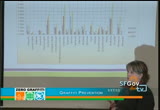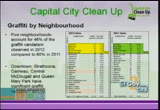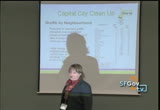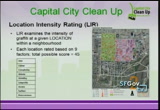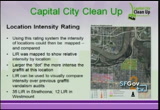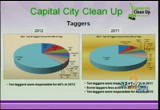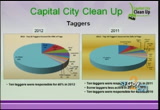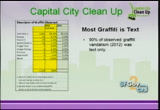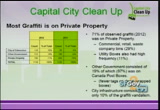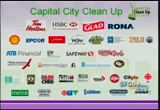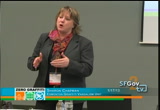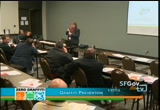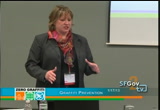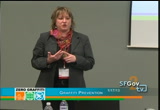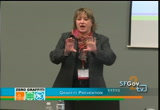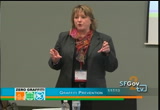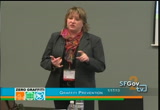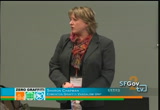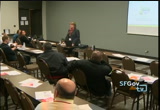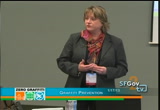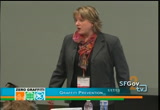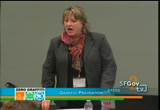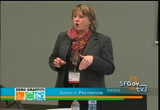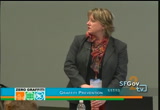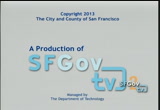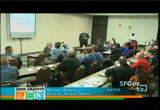tv [untitled] February 13, 2013 11:30am-12:00pm PST
11:30 am
look at the community enforcement officers woork they are doing there so next year when we go to do a hire, our bylaw officers are working with revitalization, i'll be sharing this information with them to say these are the key neighborhoods you need to be in touch with as well as the different constables and beat officers to say, look, this is a problem and this is what's trending in your neighborhood. so it's been very beneficial to us in terms of how we deploy our resources. five neighborhoods accounted for 46 percent of the graffiti vandalism observed in 2012. even though i showed you in that last slide that downtown is decreasing, it still is one of our most significant neighborhoods as far as graffiti. queen mary park. those 5 neighborhoods within the exception of one, have
11:31 am
remained fairly consistent from the beginning of the program. although the percentage of how much graffiti they have has gone down. what we're finding, too, is that while the reduction in the graffiti over all was very minimal this year, we saw huge swings in the amount of graffiti vandalism by neighborhood. so the gardineau neighborhood in 2011 had a 77 percent decrease, we saw a 200 percent increase in the neighborhood. that is telling me these are the priority neighborhoods through this year where i have to find out what's going on in those neighborhoods in terms of what we can be doing to address the programming needs of those communities. 7 neighborhoods accounted for 59 percent of the graffiti, this is visually showing you how most of the graffiti
11:32 am
continues for us to be concentrated in 7 specific neighborhoods. i'm going to have to turn the light off again. so this map is a sample of one of the maps that was created. so the original dots reflect where the graffiti was and the intensity of the graffiti that occurred in 2011. so the larger the dot, the more intensity the graffiti was at that particular location. the blue dots indicate how much graffiti or what the graffiti was at each location in terms of the incidents for 2012. so you can see from here, it's not -- i was hoping for a better visual, but in here in the hot spot neighborhood, this is one example where the hot spot neighborhood isn't as significant as the random area.
11:33 am
the random area is showing more graffiti vandalism than the hot spot neighborhood, but the intensity is pretty clear. if we're going to tackle a neighborhood we need to be looking here, we need to be looking in here. so it's been very beneficial in terms of where we should be looking in terms of our programming. this is another example of another neighborhood where it was the complete opposite, it was very clear that the random area isn't as much of an issue as the hot spot area in that neighborhood and there's hardly any tagging done in the random area in 2012. so the larger dot means more intensity of graffiti. the highest rating that you can get for location intensity rating is 45. in the old strat conan rating the highest intensity we found was 35, so a fairly intense rating and the lowest was 12 in west
11:34 am
mount and that fits with the trends of what's happening in those neighborhoods. so taggers is a very important part of the graffiti audit. when we first started the audit mark went on his observe and he was new to graffiti so him and his assistant did their best to log the tags. what we wanted to do was try and see if we could increase the percentage of tags that were identified. so two bylaw officers accompanied them throughout the audit and they assist with identification of taggers. our rate for identifying taggers has gone up to 70 percent through the audit so the information we are able to gather in terms of intell is critical in terms of enforcement efforts. last year's audit, 2011, ome and iran were two of the taggers arrested and focused on
11:35 am
by the edmonton police service based on what's going on through an every day basis, brute and chrome, which are two of the most prolific taggers we have right now, that is the focus the edmonton are going after and there's warrants being written out for his arrest. ome was arrested last year and when the officers saw, because he thinks he's been arrested, when he saw that he was arrested because all of the locations that the graffiti auditors and the bylaw officers find during the audit, they are put in the notification system. so we have those tags documented against him so they are going to levy more charges against him. so it's been clearly helpful in terms of our enforcement efforts but it is clearly seen if you can get out
11:36 am
those top 10taggers it's going to make a huge difference. they accounted for 40 percent of the activity seen this year in the audit. most graffiti we found is small, 88 percent of the observed graffiti was smalled or extra small. so basically we're not looking at big tags. the argument that we keep getting that they are beautiful pieces of art just isn't holding because they are very small pieces of graffiti. that's just the same visually. again, most graffiti is text. 90 percent of the text, with all those categories that we have where we're trying to depict what graffiti is out there, we can now go to the arts council or anybody else who wants to argue with us and say 90 percent of the observed graffiti we have in edmonton is text only. given all those options, that's what we're finding. so the other avenue that's important for us in terms of how i run my program is when
11:37 am
i'm trying to promote a mural program or i'm trying to promote community support programs, it's really important for me to basically say that you can't cut the community portion of my program because 71 percent of the observed graffiti is on private property. only 10 percent of our graffiti in those neighborhoods was observed, was on city infrastructure. other government considered 19 percent and of that 97 percent was on canada post boxes like they are the drop boxes that the mail carriers use for picking up their mail to deliver. they are being phased out, though, so again within the next year or so, those boxes are going to be phased out in edmonton so we'll see if it makes a change in graffiti results. but it also assists us in terms of how we approach them. so we take this information to canada post and basically say, get rid of the
11:38 am
gray boxes. so, conclusions. edmonton's method for auditing graffiti vandalism is unbiased and effective as far as we've been able to determine. we use the results to work with the edmonton police service to determine our other services. the graffiti index and intensity index allow for specific locations within the neighborhood. we found we had significant results over the first year, in terms of the decrease 42.7 percent and while we have leveled off this year, we are confident that by analyzing the neighborhood data we will be able to make strong changes to our programs to be able to effectively decrease that number again. five neighborhoods accounted for 46 percent of the graffiti vandalism, compared to 60, 2011, 10 taggers responsible for 40 percent of the graffiti, 88 percent of the graffiti was
11:39 am
small or extra small and 90 percent of it is text only. 71 percent was on private property. so that's basically the graffiti audit in a nutshell. but i always like to show this slide because nothing speaks better than a picture whether you are doing, how you are actually doing. and this is a tag that was created out of our logo. our logo is capital city clean up, wiping out graffiti. and the taggers are so angry with how we're doing, they've taken our logo and changed it to taking out creativity and they are stenciling it all over the city. i'm happy they know who we are and we are annoying them. this is just our sponsors, capital city clean up is fortunate to have a vast array of corporate sponsors, especially media partner.
11:40 am
any questions? >> you said that 19 percent of the incidents were on post boxes. do you guys make them pay for that? >> make the --. >> canadian --. >> canada post clean it up? we have a special relationship with canada post. it was a funny way how we got that relationship. they were arguing they couldn't keep up with cleaning them, so bylaw officers started sending notifications to the owner of the canada post boxes, who happens to be the post master general in ottawa. they take them over a week period and canada post has a contractor go out. we have two kinds of mailboxes in canada. one are the drop boxes that the mail carriers use, those are the
11:41 am
gray ones that are mostly getting tagged: other ones red letter boxes where you are dropping off your mail. those have been wrapped now and we found very little graffiti on the wrapped boxes. we are quite excited that canada post is going to be changes their policies with respect to the gray boxes and they are actually eliminating them. >> that's what we're seeing in arizona, utility companies, whether it's gas, cable, water, their boxes are being tagged. the utility companies making millions of dollars in profit don't want to pay for the clean up because they consider themselves the victim. >> we started serving tickets on them. >> interesting too as far as the boxes, the can canadian postal service has come up with a very busy deco design that is
11:42 am
really, it looks very, very nice but if you put a tag on it you can't see the tag. that's been extremely effective. those boxes get tagged i would say 1 in 10 compared to the older ones that have a nice gray surface. so that's been a very effective program and edmonton serves notice on the postal service to clean those boxes up and the telephone companies and the utility companies and they clean them up. >> question in the back? >> hi, you indicated that while conducting one of your surveys you found 90 percent of the graffiti was text only. >> yes. >> approximately how many pieces of graffiti was that 90 percent? i mean was it 50 --. >> in the 2012 audit, the graffiti that was found over that two-week period, 1,116
11:43 am
pieces of graffiti that were found. so 90 percent of that was text only. >> is that the same trend the other two years as well? >> that's a nice number, thanks. i had a second question. earlier in your presentation you mentioned, you made a comment about free walls but you really didn't give as much detail. am i to believe you are not an advocate of free walls? >> i am not an advocate of free walls. i can honestly say that, although the city is looking at putting up one but we are looking at doing it as a pilot project with the arts council. what we've done, i wouldn't say we've set them up for failure but what we are doing is we're taking the same approach with the free wall as we do with all of our other projects. as you can see, i'm really interested in having a solid foundation for the programs that we offer and that's part of why we do the graffiti audit. so we have the arts council in agreement that
11:44 am
when we coordinate putting up our free wall, we will be doing -- haven't talked to mark yet -- but we will be doing an audit of the location in concentric circles of the naibltd around where the graffiti is or where the free wall is supposed to be. that's one of the criteria. the second criteria is that in order to put up the free wall, a crime prevention through environmental design study has to be done of the area so if there are any factors that need to be changed to the physical structure of the area will have to be made and made by the arts council prior to any endorsement by the city putting it up. the other factor we're looking at is that on-going community consultation into the project is going to have to be a priority and the city community recreation department have to sign off on any public consultation. so we're looking at it being an audit process before, during, during the pilot and it's only going to be
11:45 am
run as a two-year pilot project. so we're running all of these analysis will happen before the project's initiated as well and then so that we don't have any trouble with them claiming after the fact if it has to be taken down, it's art, you can't destroy it now, any area we determine to be a free wall is going to be put on panels that are movable so we won't have any issues with that and we're going to be looking at ensuring there are guidelines posted and looking at what type of monitoring of the area can be determined, as well as who is going to be responsible for spillover so we're going to try to make the arts council, they are going to have to be responsible for maintaining the property as well as an area outside the property as well in terms of clean up on civic structures. so we're taking that sort of scientific approach in terms of
11:46 am
the analysis that's going to happen and we're running it as a project and we want to find out because you could have a community that's saying, fine and great, you are getting rid of the graffiti and in 6 months it's completely different. >> you are going to monitor the area for two years? >> yes, for two years, then we'll do post-audit. i'm hoping to be able to do two audits on this area as opposed to one year. how are we doing for time? any other questions? >> i might have missed this in the beginning, but i was curious, how do you guys get funded for this program. >> capital city clean up is a city of edmonton program. it started in 2005 as a litter reduction program and when our bylaw changed in 2008 our city council was very thoughtful in determining they needed to put their mouths were. basically
11:47 am
they were going to require the property owners clean their graffiti, then they needed to put some effort into cleaning their own graffiti as well as supporting property owners in those efforts. >> so you have steady funding? >> yes, i have steady funding for the audit and the clean up program. >> how often do you share your data with other departments? >> always. mark and i just finished finalizing it last week, but we will be holding a press conference basically when i get back, so we will be sharing the information with all the city departments as well as the city in general and going through that. we're very open about the results. the only information that we don't publish is we don't publish the
11:48 am
tagger names. if you were in our other presentation, we're very careful about not giving them air time. we don't want brute knowing he's the most prolific tagger in the city. that's not to my benefit, only to his. but we will say, for example, of the top 10 taggers one has been arrested. we will make that information known in a generic way during our press conferences. >> what type of material are you using for the panels. >> the panels? >> yeah. >> we haven't determined yet what we're going to use for the panels. it will really depend what structure we end up looking it on. we're looking at 4 locations for the free wall at this time. again, everything that i've seen shows that they don't work. we're kind of caught between a rock and a hard place on this in that the public art plan was approved by city council that includes the creation of free walls so we figure better to
11:49 am
control it as opposed to fight it because we weren't going to win the fight. again, by taking this approach we think we'll have some really good empirical data at the end of it to say, look, this is how much graffiti in that neighborhood increased over the last two years. this is how much additional graffiti was on each of those streets. this is how angry the property owners are now compared to what they were then and these are the physical changes. we'll be looking at, again, safety and security issues as well as we go through that project. any other questions? >> i just have one more. i was curious if you guys take into account any other sort of statistics, say, like the neighborhood of which area is getting tagged, do you take into account the demographics in the sense of ethnicity or their economy of, you know,
11:50 am
which type of --. >> we haven't to date, but we haven't really done that type of analysis. i think that's something we'd like to look at in the future in terms of getting down into the types of tagging. the graffiti i think it would be fair to say that the neighborhoods that have the highest incidents of graffiti tend to follow along where those business revitalization loans are or in areas of lower economic income, but we haven't done anything about ethnicity -- what you said. but we are actually looking at it. my director who just started with our branch last year is doing her master's in the area actually so that's something she wants to look at in the next few years. >> just wondering how long does it take to do an audit for a 4 by 4 block radius.
11:51 am
>> it depends on how much graffiti they find, but the audit generally takes about 10 days. >> 20 to 25 neighborhoods, we can do about 2 1/2 neighborhoods a day. >> say that again? >> two neighborhoods, 2 1/2 neighborhoods a day. you are literally 4 blocks by 4 blocks doesn't sound very big. you are doing every alleyway, behind every house, so if there's a lot of graffiti there it's pretty slow going. >> other questions? >> you have a lot of different components to your program. my question would be what are your performance measures? >> this is one of our performance measures, the results of the audit. we also
11:52 am
do a survey on an annual basis of every property owner who does a, receives a notification to remove graffiti off of their property. so we do independent survey with them. we have about a 10 percent compliance rate on our survey, which is quite good statistically, given the number of surveys we send out, so we are able to analyze the response by the community. we also do an omnibus survey, we tag on to another existing survey to determine what the community response is how they feel edmonton is doing, we've seen really positive results to that in terms of people feeling that the amount of graffiti is going down within edmonton. i have individual program surveys that i do with all our programs. for example, the professional cleaning program, all of those people are contacted individually to determine how they felt the program worked. i'm a data
11:53 am
junkie so any opportunity i have, we're really looking at that. we've done focus groups with the edmonton police service, the arts community, with school groups, various community service agencies to see what their responses to our programs, to see what other avenues we could pursue. so we have a lot of measures in place to evaluate each program area. >> as far as the city factor, do you track the square footage of graffiti removed and is that even beneficial? >> we have an estimate. we've been basing how much graffiti we've seen on thest estimates from the graffiti audit. we've take every operational department and again efts
11:54 am
estimate it. that way we track all the graffiti in our individual program areas. i could tell you exactly how much graffiti was cleaned in a wipe out, in a professional cleaning program and then take the number of notifications that come in. this year we cleaned about 50,000 square feet of graffiti. >> last question, i'm not trying to hog everything. you already ask eds your question, i see you over there. now i forget what i was going to ask because i was so engrossed and trying to hurry up and squeeze it in. after the audit do you go out there and actually clean up the graffiti? >> yes. well, we don't go out and specifically clean it, but because of the bylaw officers the company, the auditor out there, they create notifications that go out to the property owners. because we do the audit at the end of the season when it's too cold to start cleaning, so notifications are sent out to them in the spring to remove their graffiti but what we do
11:55 am
ensure is in the top 20 neighborhoods where we have the graffiti, we send out a poster, a blilts to those neighborhoods letting them know that they can contact us for assistance for clean up. we send an application and a notification to every property owner so they can access our program as well. it sounds bad that we're sending them a notification, but we ensure every time a property owner is contacted they have information on our programs so they can access them. >> okay, thank you. >> when you indicated it took 10 working days to do the audit, i'm just wondering how many people would be involved, one, three, 7 people? >> it includes mark. >> two auditors and one (inaudible). >> so about 4 people working 10 days. >> the bylaw officers, they start together so they get the same rhythm of identifying the
11:56 am
tags then they alternate but the two crew from mark's company, himself and his assistant. >> 32 to 35. >> thank you. >> any other questions? if not, i'd like it thank you very much for listening to me and i hope you found the information helpful. (applause). >> thank you. i have business cards here if anybody is interested in following up, i can just leave those there. >> you guys have some good lunch? always the worst to try to do a
11:57 am
presentation after lung. : we'll try to make it through it. before we get started i'm supposed to make sure if you have a question, we have to use this microphone here. so, you have to wait till you get the microphone in front of you to ask a question he. * lunch that's the purpose for the audio and stuff. today we're going to talk about -- basically this is what i want to do here. i've been a detective for about six years now and been with the police department 15 years. prior to that i was in the united states army, military police corps. any [speaker not understood] here? just one? prior to that when i went to college i was always looking at graffiti. i'm originally from wisconsin and there's a lot of gang graffiti back when i was growing up. i was interested in looking at it and seeing the messages that were up there. when i got into the phoenix police department, i worked four years on the road and then i started doing school resource
11:58 am
officer. the school resource officer for a couple years where i really, really learned about graffiti. in your presentation, it talked about how the schools, schools are big where they start out, okay. [speaker not understood] at home, but school is where they really get started. in the state of arizona if graffiti is done in school, a cemetery or church, it's an automatic class expeling. anybody here from arizona? where are you from? >> tucson. >> awesome. where are you from? >> i'm from [speaker not understood]. >> you work at the prison? >> [speaker not understood]. >> the jail, okay. are you guys law enforce. ment in here? any nonlaw enforcement in here? what you do? >> [speaker not understood]. >> sweet. >> [speaker not understood].
11:59 am
>> neighborhood revitalization. >> awesome. we work really, a lot hand in hand in the city of phoenix with our neighborhood services department. by far some of my best friends. we get a lot done. i can't speak enough about them. somebody asked me if [speaker not understood] can come in here. i want to try to keep the media out. i'll tell you guys about that in the future, how we don't really want these people to know, we don't want it out in the media, hey, we just busted somebody because we used facebook to get them. what are the vandals going to do? everything is going to go away. we want to make sure -- i'm telling you right now by no means am i an spederth. i will not stand up here and tell you i'm an expert on how to investigate graffiti. i am not an expert to tell you how to use technology. what i want to do with you is to show you what i have done that has been successful for me to get vandals arrested. and what we did is pretty good.
83 Views
IN COLLECTIONS
SFGTV2: San Francisco Government Television Television Archive
Television Archive  Television Archive News Search Service
Television Archive News Search Service 
Uploaded by TV Archive on

 Live Music Archive
Live Music Archive Librivox Free Audio
Librivox Free Audio Metropolitan Museum
Metropolitan Museum Cleveland Museum of Art
Cleveland Museum of Art Internet Arcade
Internet Arcade Console Living Room
Console Living Room Books to Borrow
Books to Borrow Open Library
Open Library TV News
TV News Understanding 9/11
Understanding 9/11